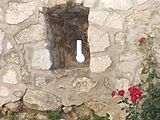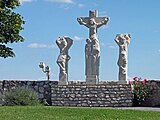Parish church Donnerskirchen
The Roman Catholic parish church of Donnerskirchen stands at a dominant altitude on a well-fortified terrace high above the town in the market town of Donnerskirchen in the Eisenstadt-Umgebung district in Burgenland . The parish church consecrated to St. Martin of Tours belongs to the dean's office in Rust in the diocese of Eisenstadt . The church is a listed building .
architecture
The four-story west tower in front of it with a clock and sound openings has an onion helmet . The choir connects to the five-bay nave with a three-eighth closure . The total length of the church is about 35 meters. The yellow facade color is divided by white bottles . A stair tower with Gothic slit windows and the two-story sacristy are built on to the north. The west portal with a split gable shows three-dimensional jewelry with fruit hangers and a cherub head . In a round arch niche above stands the stone figure of St. Martin with the foundation inscription 1739 in the base.
The single nave nave has a barrel vault with stitch caps . The masonry music choir rests on two Tuscan columns .
Furnishing
The high altar from the early 18th century shows between two pairs of columns in the altarpiece the Assumption of St. Martin in the bishop's robe and in the background the story of the coat division. Next to the pillars are the figures of St. Peter and Paul . At the transition from the choir to the nave, the figures of Joseph and St. Anna .
The left side altar shows an altarpiece allegedly from the 17th century of the Coronation of Mary and the wooden figures of St. Sebastian and Rochus . On the reredos on the right side altar, St. Andreas , flanked by the wooden figures of St. Antonius and Theresa . The pulpit from 1770 has an angel with the evangelist symbols on the sound cover and is decorated with numerous putti .
The organ dates from 1837. It was restored or expanded in 1911 after a fire. It has two manuals and a pedal .
The church has a ringing of four bells in the tones G 1 , B 1 , 2 and Es 2 , which were cast by Pfundner in Vienna in 1947 after the previous three from 1748 had been melted down during the First World War . There is also a death bell with the tone a 2 , which was cast by Jakob Montell in Wiener Neustadt in 1747 .
Surroundings
The church grounds are surrounded by a defensive wall. If the local residents sought protection in the church in case of defense, it had to be defended. For this purpose in the wall loopholes attached.
In 1992 the parish decided to create a way of the cross on the climb to the church . The Austrian sculptor Thomas Resetarits (* 1939) was commissioned with the production. He created the fourteen life-size portraits of stations out of limestone from Mannersdorf am Leithagebirge . The Way of the Cross was inaugurated in 1994. It was financed half from public funds and half from anonymous donations.
To the south there is a crucifixion group on the defensive wall . It is the twelfth station on the Way of the Cross.
history
A parish was first mentioned for Donnerskirchen in 1437, and in 1454 the first name of a pastor appeared. From 1577 to 1638 the place was Protestant. Then came the time of the Counter Reformation . Little is known about the first church building, descriptions based on a Romanesque building with a flat wooden ceiling and a Gothic apse . It can be assumed that it was significantly smaller than today's. In 1641 it says "Stone tower with clock, 2 bells, two altars, picture of St. Martin, patron saint Baron Christoph Laisser". In 1674 the church is described as "in bad shape".
In 1653 Paul Esterházy (1635–1713) acquired the Leisserhof in Donnerskirchen and became the patron saint of the church. At his expense and as a result of donation campaigns by the community, the old church was demolished in 1676 and the current baroque building was built in the same year using old masonry . The consecration took place on April 7, 1680 by Cardinal Leopold Kolonitz (1631-1707).
In the Turkish year 1683, the church was not damaged except for a silver chalice stolen by German imperial soldiers. Thanks to donations from families in Donnerskirchen, the interior and exterior of the church could be improved again and again, for example in 1739 with the statue of St. Martin above the portal.
Renovations took place in 1872 and 1912. During the renovation in 1970, the former white exterior paint was changed to Schönbrunn yellow . Have the old white color nor the local coat of arms and the Hungarian and Croatian name of Donnerskirchen out in German on both occasions White Church . During the interior renovation in 1973/74, old wall paintings came to light.
literature
- The art monuments of Austria. Dehio Burgenland 1976 . Donnerskirchen, Catholic parish church hl. Martin, pp. 56-57.
Web links
- The Catholic parish church of St. Martin (mountain church). In: Donnerskirchen - Tourism. Retrieved February 27, 2017 .
- Church history. In: chronik-donnerskirchen.at. Retrieved February 27, 2017 .
- Bells of the Donnerskirchen parish church on YouTube. Retrieved February 27, 2017 .
Individual evidence
- ↑ a b The Catholic parish church of St. Martin (mountain church). Retrieved February 27, 2017 .
- ↑ a b Donnerskirchen / Fertöfehéregyháza Catholic parish church. Retrieved February 27, 2017 .
- ↑ Chronicle from 1910 to 1917. Retrieved February 27, 2017 .
- ↑ Church history. In: chronik-donnerskirchen.at. Retrieved February 27, 2017 .
Coordinates: 47 ° 53 ′ 57 " N , 16 ° 38 ′ 30.8" E



